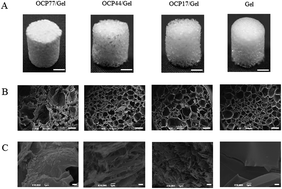Dose-dependent enhancement of octacalcium phosphate biodegradation with a gelatin matrix during bone regeneration in a rabbit tibial defect model
Abstract
The present study was designed to investigate how the dose of granular octacalcium phosphate (OCP) in a gelatin (Gel) matrix affects its bone regenerative and biodegradable properties in a rabbit tibia defect with a depth of 7 mm and diameter of 6 mm made in the cortical bone to bone marrow space. A spongy OCP/Gel rod, which corresponded to the defect shape, was prepared by mixing OCP granules with diameters of 300–500 μm in a gelatin matrix that contained 17–77 wt% OCP. Lyophilization and dehydrothermal treatment were performed to cross-link the materials. OCP/Gel composites were characterized by scanning electron microscopy, X-ray diffraction, and Fourier transform infrared spectroscopy. At 4 and 6 weeks after the implantation, soft X-ray and micro-CT were taken, followed by histomorphometric analysis using decalcified specimens. The results showed that the composites had a porous structure of up to 500 μm in diameter and maintained the OCP structure regardless of its content in the gelatin matrix. The OCP/Gel composite with a higher OCP content showed greater bone regeneration and tended to undergo faster biodegradation in both cortical bone and bone marrow regions. These results suggest that the biodegradation tendency of the composite could be accelerated by increasing the OCP content. This is likely due to the effect of OCP together with gelatin matrix, which results in higher osteoconductivity.


 Please wait while we load your content...
Please wait while we load your content...